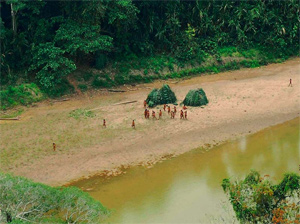Uncontacted Amazon tribe spotted by plane in Peru
Uncontacted Amazon tribe spotted by plane in Peru
mongabay.com
October 21, 2007
A group of uncontacted indigenous tribesmen were spotted by plane in a remote part of the Peruvian Amazon last month, according to Survival International. The region is threatened by illegal mahogany loggers.
“The Indians were spotted on the shores of the Las Piedras river in Peru’s south-eastern Amazon,” said the NGO in a press release. “They left their shelters on the beach to watch the plane, chartered by Peru’s Environment Agency, fly overhead. During the plane’s second pass, one of the Indian women, carrying arrows and accompanied by a small boy, gestured aggressively, whilst the rest of the group sought refuge in the undergrowth.”
The sighting, notes Survival International, comes shortly after the representatives from Perupetro, Peru’s state oil company, compared the existence of uncontacted tribes in Peru to the Loch Ness monster.
 © Heinz Plenge Pardo / Frankfurt Zoological Society Rory Carroll of The Guardian write that the group may be members of the Mascho Piro tribe: “Similar types of huts were spotted in the region in the 1980s, prompting speculation that this was the Mascho Piro, a tribe which erects temporary dwellings near riverbanks during the dry season when it is easier to fish, then move back into the forest during the wet season.” |
“It is absurd to say there are uncontacted peoples when no one has seen them,” said Daniel Saba, chairman of Perupetro.
Indigenous rights groups say the sighting is proof that such people exist. Survival International estimates that there are at least 15 uncontacted tribes in Peru, many of which are likely at risk from encroachment by loggers and the oil industry.
“What further proof is needed of the uncontacted tribes’ existence?” asked Stephen Corry, director of Survival International. “There they are for all the world to see – Peru’s most vulnerable citizens whose government now needs to do its duty by them. It is time for their rights to their land to be recognized and respected, for oil and gas exploration to be banned from their territories, and for all loggers and other outsiders to be removed.”
“The uncontacted tribes exist,” added AIDESEP, Peru’s national Indian organization. “If we don’t act now, tomorrow could be too late.’
Related
Photos of spear-wielding uncontacted tribe in the Amazon rainforest (May 30, 2008) A fly-over of a remote part of the Amazon rainforest spotted members of what is believed to be one of the world’s last uncontacted tribes. The Amazonians reacted aggressively to the fly-over, with bow and arrows aimed at the plane, according to Survival International, a group that works to protect indigenous peoples.
Uncontacted Amazon tribe spotted by plane in Peru (October 21, 2007) A group of uncontacted indigenous tribesmen were spotted by plane in a remote part of the Peruvian Amazon last month, according to Survival International. The region is threatened by illegal mahogany loggers.
Ancient Amazonian technology could save the world (May 17, 2007) Terra preta, the ancient charcoal-based soil used by ancient Amazonians to create permanently fertile agricultural lands in the rainforest, is getting serious consideration as a means to fight global warming and meet domestic energy demand, reports an article in Scientific American.
Amazon natives use Google Earth, GPS to protect forest home (November 14, 2006) Deep in the most remote jungles of South America, Amazon Indians (Amerindians) are using Google Earth, Global Positioning System (GPS) mapping, and other technologies to protect their fast-dwindling home. Tribes in Suriname, Brazil, and Colombia are combining their traditional knowledge of the rainforest with Western technology to conserve forests and maintain ties to their history and cultural traditions, which include profound knowledge of the forest ecosystem and medicinal plants. Helping them is the Amazon Conservation Team (ACT), a nonprofit organization working with indigenous people to conserve biodiversity, health, and culture in South American rainforests.
Amazon Stonehenge suggests advanced ancient rainforest culture (May 14, 2006) The discovery of an ancient astrological observatory in Brazil lends support to the theory that the Amazon rainforest was once home to advanced cultures and large sedentary populations of people. Besides the well-known empires of the Inca and their predecessors, millions of people once lived in the forests and shaped the environment to suit their own needs.
Second “uncontacted” tribe in Amazon rain forest threatened by loggers (May 26, 2005) PORTO VELHO, Brazil (Reuters) — A Brazilian Indian tribe armed with bows and arrows and unseen for years has been spotted in a remote Amazon region where clashes with illegal loggers are threatening its existence.